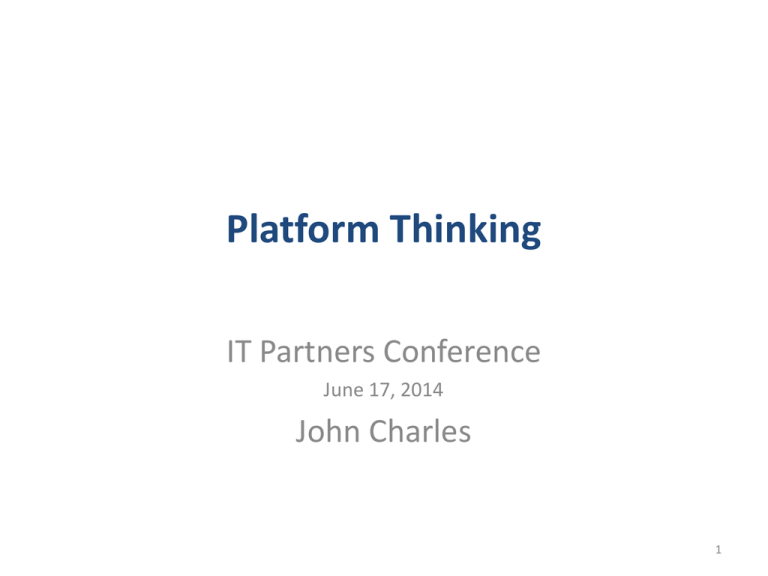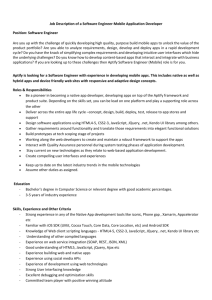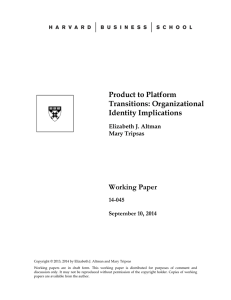Platform Thinking
advertisement

Platform Thinking IT Partners Conference June 17, 2014 John Charles 1 Platform Thinking – What Changes? Design • To be a platform, a system must provide a useful function or service and allow 3rd party access Network Effects • Platforms have communities, products have features Value • Platforms open themselves to and gain enormous value from 3rd party contributors/developers Platform-based Ecosystem 2 For Nearly 2 Decades the Microsoft Platform Beat the Apple Product Source: Parker & Van Alstyne Microsoft opened their platform, licensed widely, and built a huge developer ecosystem. Apple kept their product closed. 3 You know your business model is working when users of your platform do something you didn’t expect Model T Platform Hay Carrier Flour Mill Race Car Mobile Church Sawmill Snowmobile Goat Carrier 4 Does Open Work? “We tried to create every feature in the world and said, ‘O.K., we can do it, why should we let a third party do it?’” (MySpace cofounder) DeWolfe “We should have picked 5 to 10 key features that we would be totally focused on and let other people innovate on everything else.” The Rise & Ignominious Fall of MySpace – Business Week 2011 5 Platform Thinking – What Changes? • • Goal is transactions volume & creating user value Don’t need to own the one-off resources/apps – simply convince those providers to join you Value Strategy Platform provider focuses on most valuable apps Value increases as others add to platform’s “Long Tail” Innovation • Platforms can be adapted to countless needs & niches that the platform’s original developers could not possibly imagine Source: Van Alstyne (2014), “Platform Shift: How New Biz Models are Changing the Shape of Industry” 6 Change The Pace of Change Seemed Somewhat Linear in the Past – but its Exponential Nature is Now Clearly Apparent But, we must now optimize for: • Time to market • Rapid changes • User experience We optimized for: • Performance • Reliability • Cost Time 7 Much of Higher-Ed Seems to be Suffering from Boiling Frog Syndrome • Higher-ed’s biggest challenge is its time zone. It’s 9:30am, June 17, 2014 on the East Coast… …but the app portfolio at many institutions is stuck in the late 1990s or early 2000s • Higher-ed was ahead of the curve in terms of its use of technology… …but then the curve ran us over 8 Google’s Eight Pillars of Innovation Innovation Have a mission that matters Strive for continual Think big but innovation - not start small instant perfection Look for ideas everywhere Never fail to fail Spark with Be a imagination Share continue everything fuel with platform to learn data and iterate 9 Why IT Organizations with Traditional IT Service Delivery Models and Practices Struggle to be Responsive – and Struggle to Support Innovation Gartner’s TCO analysis shows that 80% to 85% of an IT organization’s budget is consumed by simply “keeping the lights on” (KTLO). Backlog of IT Projects 100% Capacity for New Projects 80% 60% 40% KTLO (Enhance, Maintain, Operate) 20% 0% IT Budget 10 Consumerization Has Radically Changed User Expectations for Enterprise Apps Source: Innovator’s Guide (Mendix) 11 To Remain Relevant, Higher-Ed IT Units must Reduce the Amount of Change-Induced Resource Consumption – the Key Enabler for Lowering KTLO and Becoming more Responsive Pace-based Application Change Strategy Platform-based IT Service Strategy & Tools Lower the changeinduced resource consumption Reduce the app development overhead for all IT service providers • • • Innovation & differentiation apps need to change frequently Whereas, the core codesets for ERP & other system-of-record apps do not • Shorten the app development time Accommodate local workprocess and workflow differences Responsive IT Operations & Services Value Creation • • Improved decision-making Improved processes 12 Transformation Strategy Pace-based Application Change Strategy Innovation & Pilot Project Apps App Systems that Create Differentiation All Other Mission Critical Apps (ERP, etc.) Daily or Weekly Changes Monthly or Quarterly Changes Semi-annual or Annual Changes Platform-based IT Services Strategy & Tools - Buy or build new apps with robust sets of APIs - Configure, but do NOT customize base code sets for newly acquired apps - Publish APIs for all new apps - STOP customizing legacy apps - Publish APIs for legacy apps - Change &/or add functionality “on top” of new & legacy apps using APIs & modern app development platforms - Use mobile-ready, change-friendly app development platforms & toolkits 13 Unlock Business Value & Enable Innovation BUILD Applications Better & Faster • Reduce time to market • Accelerate app development by 10x RESPOND Quickly to Changes & Opportunities • Capitalize on new opportunities before they are gone • Accommodate constant updates ENABLE the Business & Accelerate Innovation • Eliminate project backlog bottlenecks • Open platforms to extension by others 14 Transformations in Responsiveness and Support for Innovation within the IT@MIT Ecosystem “Value-Add” for Distributed IT Units Distributed IT Capacity for New Projects Central (IS&T) Capacity for New Projects KTLO Reduction Productivity Expansion IS&T Transformation Central (IS&T) Capcity Consumed "Keepingthe-Lights-On" 15 Timeline ✔ Jan-Jun • Listening Tour & Community Engagement (Consensus Vision, Goals, & Guiding Principles) Jul-Aug • Formulate Findings & Develop Strategies for Realizing the Vision • • • • SepOct • Community Engagement in Finalizing IT Strategies NovDec • Approval of IT Strategic Plan & Publication of Implementation Roadmaps Technology plan & associated proof-of-concepts Financial plan & associated funding models Governance plan & associated policy agenda Communications plan & associated collaboration platforms 16 If you believe in the power of people connecting… …embrace platforms If you converted your product/service to a platform… …what would it enable? 17 Thank You! Questions or Comments? 18





